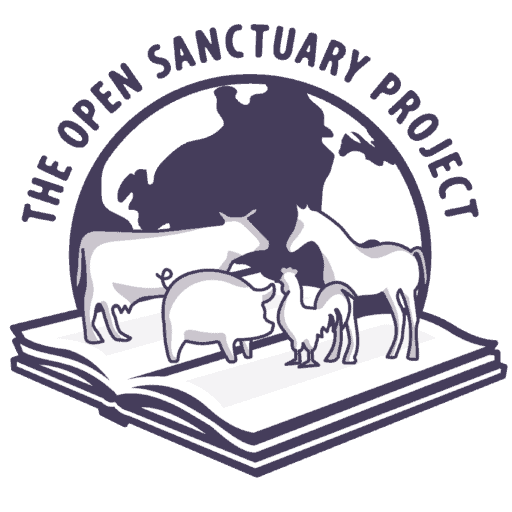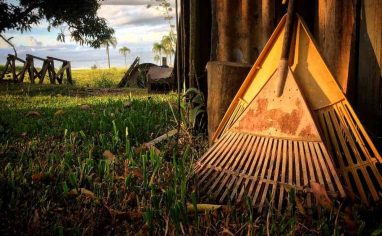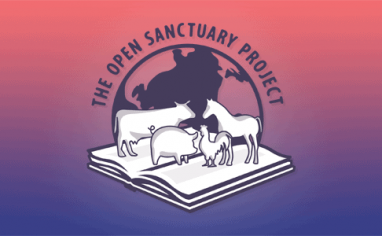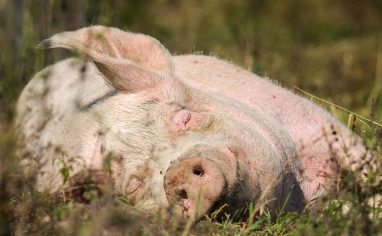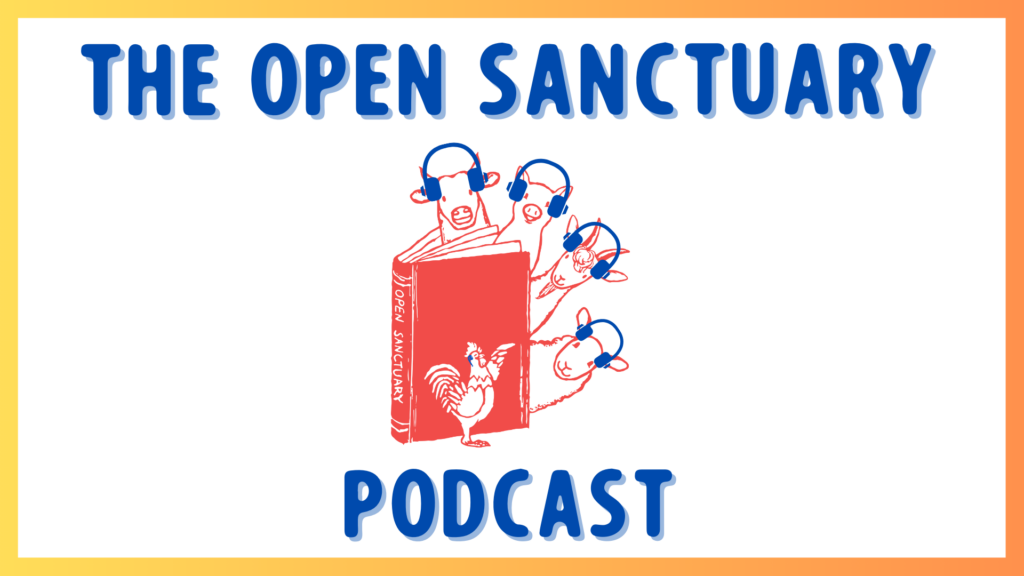
Subscribe To The Open Sanctuary Podcast
If you’d like to get the latest episodes of The Open Sanctuary Podcast, you can subscribe for free on all Podcast platforms, including Apple Podcasts and Spotify!
Episode Notes
Community Education Specialist Andie Springirth and Executive DirectorThe individual formally in charge of final decision making at an organization, who sometimes works closely with the organization’s Board of Directors. Sometimes a Founder is an Executive Director, especially early in a nonprofit’s growth stages. Mckenzee Griffler discuss combating biases that can harmThe infliction of mental, emotional, and/or physical pain, suffering, or loss. Harm can occur intentionally or unintentionally and directly or indirectly. Someone can intentionally cause direct harm (e.g., punitively cutting a sheep's skin while shearing them) or unintentionally cause direct harm (e.g., your hand slips while shearing a sheep, causing an accidental wound on their skin). Likewise, someone can intentionally cause indirect harm (e.g., selling socks made from a sanctuary resident's wool and encouraging folks who purchase them to buy more products made from the wool of farmed sheep) or unintentionally cause indirect harm (e.g., selling socks made from a sanctuary resident's wool, which inadvertently perpetuates the idea that it is ok to commodify sheep for their wool). farmed animalsA species or specific breed of animal that is raised by humans for the use of their bodies or what comes from their bodies.. Since much of human thinking, feeling, and behavior is guided by our biases, understanding biases that can negatively impact farmed animals is an important undertaking for animal sanctuaries. As communities that challenge the dominant treatment and sociocultural narrative of farmed animals on a daily basis, sanctuaries can utilize their unique learning spaces alongside a deeper understanding of bias to help folks (re)imagine more compassionate ways of understanding and being in relationship with farmed animals. In addition to exploring what biases are and how they develop, this episode highlights three actionable strategies sanctuaries can use to help folks who participate in their educational programming avoid and overcome biases that can negatively impact farmed animals.
—
This Episode’s Referenced Open Sanctuary Project Resources:
Understanding Biases that Can Negatively Impact Farmed Animals and How to Help Folks Overcome Them
5 Ways to Combat Biases that Can Harm Farmed Animals Infographic
Episode Transcript (Auto-GeneratedThe following content was transcribed through an automated process and may contain transcription errors or misspellings.)
Andie Springirth: Hello everyone and welcome to another episode of the Open Sanctuary Podcast. I am Andie Springer, the community education specialist, and I am here with my friend and colleague, Mckenzee Griffler, our executive director. Today, we are here to talk about combating biases that can harm farmed animals. Having biases is, of course, a part of human nature. I have them, Mckenzee has them, we all have them. But they are so powerful in guiding the way we humans think about, feel about, and even act towards farmed animals that they have consequences, and oftentimes in ways we really do not want or intend. So for this reason, we think it is critical for sanctuary educators to have a clear understanding of what biases are and know how to help folks who visit their learning spaces overcome them so they can practice more compassionate ways of being in relationship with farmed animals. About a year ago, we released a written resource that goes into more detail on this topic. And of course, we hope you will take a look at that when you have the time; we also know you have a very long to-do list in front of you. So, today, in our efforts to make this information as practical and accessible as possible, we are going to briefly define bias, summarize how it develops, and then give you three actionable strategies that you can use to help folks who participate in your sanctuary’s educational programming avoid and overcome biases that can negatively impact farmed animals.
Mckenzee Griffler: So, Andie, I feel like a great place to start this discussion would be for us to just get a working definition of what we are talking about when we are talking about bias, especially, you know, because I feel like there are a lot of different ways that one could think about bias, both in terms of farmed animals and outside of farmed animals. So, what are we really talking about here for an educational framework?
Andie Springirth: That is a really great question, Mckenzee. Yeah. So, in general, bias can be thought of as a particular tendency, inclination, feeling, or opinion about a person, group, thing, idea, or even belief that is importantly not founded by known facts. And although they can be neutral or positive, so one example I like to tell people of a neutral bias is that I think delphiniums are the most beautiful flowers in the world. Biases are predominantly negative and based on stereotypes that usually result in discriminatory practices and harmful actions. So we are going to give you some examples of biases that can negatively impact farmed animals in just a moment. But I do think for the purpose of our time today, it is important just to make folks aware that there are two overarching types of biases: there are conscious biases and there are unconscious biases. So conscious biases are biases that folks develop and hold that they are aware of. And individuals with conscious biases are typically very explicit about their founded beliefs and attitudes, and they act accordingly with intent. So, there are many different types of conscious biases that people hold against farmed animals. One commonly held bias that you have probably heard of out there, listeners, or even battled or maybe even held at one point in your own life is that pigs are dirty, despite actually being exceptionally clean animals. Unfortunately, you know, this belief has real consequences since being dirty, quote unquote, is typically considered a negative characteristic by us humans. And sadly, what research has shown us is that animals who are even just perceived in negative ways like this tend to be treated with less moral concern, as of course is the case with pigs. You know, unfortunately, I think a lot of people need some sort of rationalization as to why we are treating these animals so poorly. So, it makes sense that as a species, certain humans might say, “Well, we have this justification for doing it. Therefore, that makes it a moral choice to do these terrible things to animals.” So, that makes a lot of sense to me. But, but what about unconscious biases as they pertain to farmed animals?
Mckenzee Griffler: That is a good question. Unconscious biases are the opposite. These are biases that folks develop and hold that they are actually unaware of. And what is interesting that I have learned about them is that they are often in direct contrast to the conscious beliefs and values that people think they hold. But regardless, you know, these unconscious biases have a very heavy influence on the way that folks think, feel, and behave towards others. And this is usually without even realizing it. I have to imagine that there are a lot of different ways that we can hold unconscious biases both within and without the context of farmed animals.
Andie Springirth: Yeah, there are literally hundreds, and if and when, hopefully, our listeners take a look at that resource, you are going to see not hundreds, but you will see a much longer list than we are going to give you today. And for the sake of our time today, actually, I am just going to give folks two examples that you are very likely to encounter with sanctuary visitors. The first one is likely something you have come across and know very well. That is the unconscious bias we call speciesismA form of discrimination based on species membership; the belief that different species of animals deserve different ethical considerations regardless of whether they have similar needs or interests.. And, you know, essentially what that is, is the negative beliefs, emotions, and behavior toward others based on their membership in a certain species group. So this bias, speciesism, it results in the belief that some animals are less morally important than humans and that some species of non-human animals are also less morally important than other non-human animals. Speciesism sadly also often results in an inability to feel empathy for certain animal species, as well as very sadly, the ability to commit harmful acts against these particular species that, you know, we would never commit against humans or other species of animals. So, as an example, someone might not give any consideration to the harm that comes to cowsWhile "cows" can be defined to refer exclusively to female cattle, at The Open Sanctuary Project we refer to domesticated cattle of all ages and sexes as "cows." as a consequence of their attitudes and behaviors toward them, but still take harm towards dogs into very strong consideration.
Mckenzee Griffler: That makes a lot of sense.
Andie Springirth: Yeah, we have all definitely seen this, I am sure, in the sanctuary world several times, but even amongst farmed animalA species or specific breed of animal that is raised by humans for the use of their bodies or what comes from their bodies. species, you know, I am sure a lot of educators have seen varying degrees in the kind of, quote unquote, hierarchy of speciesism. So, another example within that is folks tending to give more moral weight towards mammalian species versus animals like reptiles and fish. The second example of unconscious bias I want to give folks today is hyperbolic discounting, and that sounds like a scary term, but essentially what it is, is just the tendency to prioritize the present over the future. So I found it very interesting in my research about biases that this actually evolved as a mechanism to help our ancestors focus on what might kill us now versus later. But today, of course, it can limit our ability to take action and address important and complex issues that we may not feel the direct impact from until a bit further down the road. So, for example, in the context of our work as sanctuary educators, you may come across folks who understand that something needs to be done to address the issues facing and related to farmed animals like climate change, food justice, and of course, animal exploitationExploitation is characterized by the abuse of a position of physical, psychological, emotional, social, or economic vulnerability to obtain agreement from someone (e.g., humans and nonhuman animals) or something (e.g, land and water) that is unable to reasonably refuse an offer or demand. It is also characterized by excessive self gain at the expense of something or someone else’s labor, well-being, and/or existence.. But it is hard for folks to see, not not all folks, but a lot of folks, to see how the changes and sacrifices required for future generations are worth considering right now. And this is, you know, a very prime example of this hyperbolic discounting bias.
Mckenzee Griffler: And I have to imagine that one is a little bit harder for some folks to maybe wrap their heads around. I think when you explain speciesism, even if it is not necessarily something that somebody has encountered before using such language, I think it makes sense from like an equitable perspective, but I can see how hyperbolic discounting would be a much more challenging bias to address in terms of meaningfully taking meaningful action to address it.
Andie Springirth: Yeah. Yeah. That is something I will I will say it here now, and it is not going to be the last time I am going to say it in this episode, but and this is not to discourage anybody. In fact, I am going to I am going to do the opposite as we move through here, but biases can be really challenging to change. They they take a long time. So yes, hyperbolic discounting, Mckenzee, is a great example of that, that we have to sustain our efforts here.
Mckenzee Griffler: Yeah. How do these and this this is probably a big question, but I am wondering if it would be helpful to think about how these biases develop as a way of thinking about how one can address them.
Andie Springirth: That is a really good question. So when I was doing my research for this topic, for the written resource we have on our website, I went in with the assumption that our biases are just learned through socialization. And of course, that is true. That is one way that they develop. So from a very young age, many humans, including myself, are exposed to a lot of images and messages about farmed animals that, you know, really shape the way we understand and relate to them. And this can be through conversations. It can also often be through storybooks, movies, photographs, paintings, whatever. I am sure this was the case for many of our listeners out there, too. But unfortunately, those messages and images were and are inaccurate and demoralizing, but they are very powerful nonetheless. And so, over time, with repetitive exposure in our various social settings, these ideas and conceptualizations and representations of farmed animals, they we absorb them, and they grow and they crystallize, and this is where they kind of turn into these unreasoned beliefs or harmful biases. So just like a little anecdote, I often think about this, even though this is over 12 years ago now, before I began my journey toward veganismA movement and way of living that seeks to eliminate the exploitation of and cruelty to nonhuman animals as much as possible. Often, veganism is defined synonymously with a plant-based diet, although veganism includes abstaining from elements of animal exploitation in non-food instances when possible and practicable as well.. I actually explicitly remember having a conversation with my father-in-law when I said, quote, “It is sad that cows are killed, but they are here on earth to give us food.” And, you know, I reflect on that in my work as a sanctuary educator. Some people might be like, why would you think about that? But I think about that because it allows me to relate to other people that I am speaking with in our educational spaces that, of course, I know this was an unreasoned belief that I had not examined closely yet, but I had learned this as a kidA young goat in all the spaces that I had grown up in. And a lot of people are coming into our sanctuary learning spaces with this same kind of mindset that they had learned. Okay, so the second way that these biases develop, and this was the one that I was honestly surprised to read about, and this is that biases can also develop as a result of innate factors. So I actually already mentioned one when we were talking about unconscious biases, that was the hyperbolic discounting, which was, you know, an evolutionary bias that developed out of a need to survive, but, you know, there are other innate factors that play into this that can, I want to say, help us, but they because they do not help us in all cases, but that allow biases to develop. These are things like flawed memory, aging, issues with paying attention, and emotional input. And research has also suggested that many of our gut feelings about certain species are the result of an evolutionary process, other evolutionary processes that aim to help our ancestors, you know, make decisions for survival-related purposes. And I thought that was really important to know. I I I was surprised to read that. You know, I think I think it is helpful in terms of actually educators being able to empathize even a bit more with the folks who come into their spaces and understand that we are digging even deeper actually sometimes than our socialization over the last several decades. Maybe we are going back a long time ago. So, you know, just to give a quick example of this, it is believed that there are certain unappreciated species-specific behaviors and even physical attributes of some animals that can actually arouse emotions in folks that associate those behaviors and attributes with ill-perceived characteristics. And without careful guidance and a deeper understanding of what folks are witnessing when they see other animals, sometimes for the first time, exercising behaviors in behaviors that they have never seen before, including in sanctuary settings. Of course, it is it is really not hard to imagine how misconceptions about certain species can be formed.
Mckenzee Griffler: That makes a lot of sense. I can imagine that some of these things that we are talking about are behaviors and patterns that were patterned into us when we were developing as a species to protect us. So, we might be taking certain attributes and looking at them, and we might have a sense memory from, um, tens of thousands of years ago, saying like, this is not a behavior that is safe for me. So unlearning that or looking at it and contextualizing it must be quite a big process for everybody.
Andie Springirth: Exactly. Yeah. And this is, it might be surprising, which it was for me. It it might feel like, uh, how can we possibly push back against our evolution, but we can. And that is really where the good news comes in here is that over time with sustained effort. We as educators in our, you know, very unique sanctuary learning spaces can help folks avoid, reduce, and actually overcome biases, you know, that can negatively impact farmed animals.
Mckenzee Griffler: I am sure there are so many different tactics that one could take for this kind of sustained effort. For the sake of our listening audience, let us talk about three. Let us talk about three ways that we can help overcome these biases, if you do not mind.
Andie Springirth: Yeah, of course. Yeah, three is a good number. And I do I do have to say here too, which I will plug in at the end as well, is that we have way more than three in our written resource. And some of them, you know, are even more specific than the ones I am about to mention here. But yeah, just a quick plug in to to encourage folks to take a look because they are very easily implementable right now in your spaces. But the first one that I think is really important is just to raise awareness, and that may sound really basic, but it is incredibly important because a lot of people are hesitant to see themselves as participating in bias to begin with. And if I reflect on this myself, I can relate to that actually, you know, sometimes people push back and may even bring something up, hey Andie, did you realize this about yourself, and I will be like, you know what, I did not actually, or maybe unconsciously I did, but again, a lot of those things, yeah, we just need to be made aware of. So one of the first things we can do in our learning spaces is just kindly remind folks that it is a natural human tendency to make judgments about others based on first impressions and preconceived ideas. This is just an unfortunate reality, right, of our human existence, but we all do it. The second part, importantly, is that we also need to help folks recognize that many of our biases do affect the way we behave towards others in ways that can directly contrast with sometimes the very proud beliefs and values we think we hold, and importantly, they can cause harm, direct harm, indirect and direct harm. So, you know, just allowing folks to think critically and recognize their biases toward farmed animals and the ways that they impact them, you know, it gives them the opportunity to take action to avoid them and prevent acting on them. So as one practical exercise you can take home right now and do is to ask the folks in your your learning space to try and think about in real time any stereotypes, common messages, or general impressions they are aware of that are related to farmed animals or any particular species in your in your setting. So, as an example, in my work as a sanctuary educator, I came across a commonly held belief that birds like chickens and turkeysUnless explicitly mentioned, we are referring to domesticated turkey breeds, not wild turkeys, who may have unique needs not covered by this resource. are unintelligent. This was very common. This was a regular. I am sure a lot of our listeners have heard like, “Won’t turkeys drown in the rain?” You know, that is a really common line that I am sure a lot of folks have heard. So, if and when you hear this, you know, you can ask folks explicitly to reflect on whether they think there is actually any truth to that statement or that belief, you know, you can ask them where where did that idea come from? Like, where did you hear that? Or where have you seen it reinforced? And and also, do you know of any contrasting stereotypes, messages, or impressions about birds like chickens and turkeys, you know, and if they say no, well then, you know, that is part of our wonderful work as sanctuary educators is is then going the next step and and helping them counter these really unreasoned beliefs about them.
Mckenzee Griffler: And I am sure for a lot of these beliefs that people might hold, they might have no idea where they have heard that. You know, it is just so subsumed in cultural messaging, which again was kind of created to reinforce this treatment of these animals.
Andie Springirth: Exactly. Yeah. Yeah. This is definitely one way that, you know, these exploitative institutions related to farmed animals are able to not only manifest but exist and stay. So yeah, we are trying to, exactly, we are we are trying to knock knock those down. So that was one one strategy you all can implement right now. A second thing you can do is to help folks develop a rationally based understanding of farmed animals. So most people’s biases, as we kind of just mentioned with the example of chickens and turkeys regarding their intelligence, you know, they do not align with any empirical evidence or biologically based knowledge. Oftentimes it is in direct contrast to the evidence and knowledge and research that we have on these species. So it is important for sanctuary educators to explicitly acknowledge things like farmed animals are sentient. They can feel physically and emotionally. They are intelligent and have social lives. They are able to exercise agency. They have their own unique behaviors, perspectives, and needs, etc.. One way you can do this, you know, in addition to just saying that, is actually reinforce it by interpreting certain resident behaviors and communications or communicative cues and emotions that you all may be witnessing as you are facilitating your program. So long, of course, as you can do this accurately, and that is very important. Depending on the species and the individual, those things look different. You can also point out how certain behaviors and misunderstandings of farmed animals may correspond to attributes that are commonly associated with certain qualities that may impact their ability to be seen as exploitable. So, some folks might point it out themselves, and that is that is important. You can encourage them to do that as well. But you you all you may be standing there, you know, outside of someone’s enclosure and see a pig walk into a mud wallow and there we go. Someone might be like, “Ew, that is so gross.” You know, and that is your opportunity to say, “Guess what? Pigs do this because X, Y, and Z.” Which we know there are several reasons, right? And that is important to be explicit about this.
Mckenzee Griffler: Right. Right. And I do want to also to flag an important thing to keep in mind is I think it is important for educators to, while we talk about relative intelligence of species, also have a lot of care in that subject because I think we can assign a little bit maybe too much value to human-assigned concepts of intelligence and what that means, how we may or may not be able to morally exploit others. Complicated subjects.
Andie Springirth: That is a complicated subject, but I really appreciate you mentioning that, Mckenzee. Thank you. Yeah, that is I I do want to also just add on to that and just say that, you know, all lives are intrinsically valuable regardless of, you know, their specific intelligence. Let us say that I echo that sentiment. Thank you. So the third strategy I want to share with you all today is simply to work at building a community in your sanctuary space. And I really cannot emphasize this enough. Anybody who has had a conversation with me, especially over the last five years, has probably heard me say we need to work, you know, structuring our educational programs around encouraging people to come back so that we can continue to have these conversations and experiences with folks and that they feel safe to do so. So, yes, just to reiterate what I mentioned several minutes ago, changing people’s biases, especially towards farmed animals, it can take a really long time. So, our efforts need to be sustained. And one way we can do this that is helpful for other folks and it is helpful for ourselves is by yeah, just really building community into our programs more than just one-time visits, which I know is sometimes it is and has to be the case, but if we can build community into our programs, we are going to have a much more significant impact.
Mckenzee Griffler: Yeah. And I just have to imagine that the idea of trying to build a sustained community, while a really important goal, that must feel really daunting to people, to educators who, you know, have all these other things that they have to consider. What do you think would be like the first step towards an educator wanting to try to build out more of a sustained community? Like how can they interpret that into their practices or their lesson plans or their strategies to get people to think about coming back?
Andie Springirth: Well, honestly, I think one of the very first steps, and I mentioned this in the strategic planning resource on educational programming, is to actually get to know your immediate community around your sanctuary. It is really important to know who is local and to understand the audience, you know, that is predominantly coming to visit. Of course, we we know there are plenty of people who come from outside your local community, and that is that is important too to keep in mind, but, you know, and that depends also on the area that that you are in. Of course, some particular regions are more attractive to tourists, you know, and visitors, but yeah, I would say, you know, really getting to know the community that is local to your sanctuary and finding out what their needs are, find out what their interests are, you know, find out how you might be able to connect your missionThe stated goals and activities of an organization. An animal sanctuary’s mission is commonly focused on objectives such as animal rescue and public advocacy. and your vision with things things that are already valued in the community around you and then work to build those bridges through your programming. I honestly could go, that is an episode, Mckenzee. It it is an episode like I have just like flooded right now. I am like, and do this and do that. But I am going to leave it there if that is all right because I think that is that is one thing, you know, just a more of a reflective exercise for folks to think about.
Mckenzee Griffler: Absolutely.
Andie Springirth: Yeah.
Mckenzee Griffler: Well, thank you so much for sharing so much about this topic of which I know from reading your wonderful resource that you released, you have so much more to say about it, and I really genuinely hope people check out the show notes and just read through that resource if they have any interest in the topic because I know that they are going to get some really important nuggets of information that will help make a difference in helping people create more understanding for animals, especially farmed animals.
Andie Springirth: Yeah. Yeah. Thank you so much, Mckenzee, for joining me. I really appreciate it. And please feel free to reach out to us, friends. We love hearing from you if you have comments about this particular episode or the written resource. You know, my ears are always my ears and eyes are always open to receiving feedback and extended conversation and dialogue. So, thank you so much. Thanks, friends. Bye-bye.

Got A Podcast Idea? Contact Us!
If you have a topic or question you’d love to hear our staff address on The Open Sanctuary Podcast, please get in touch via our contact form!
